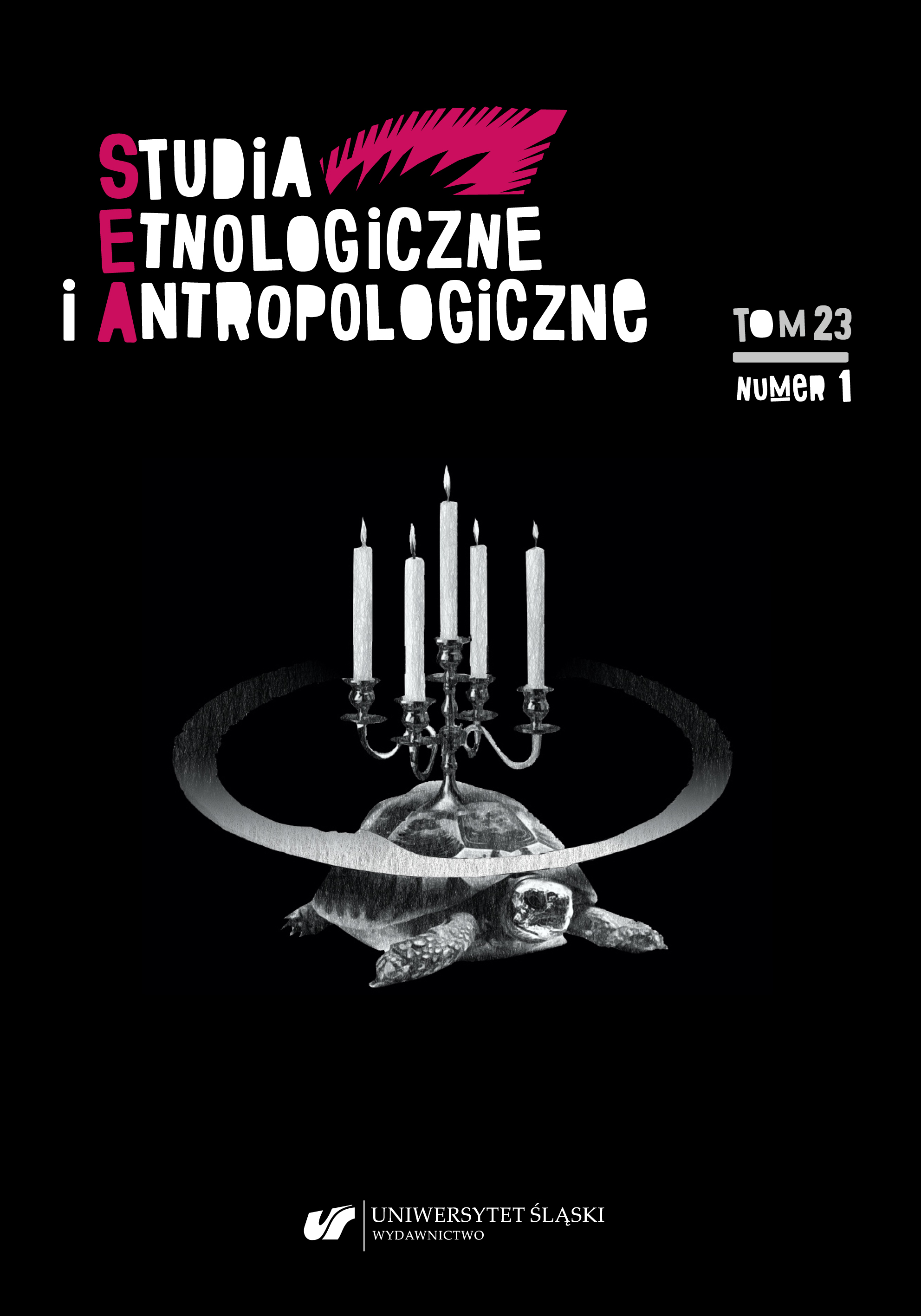Amougou E., 2004, La question patrimoniale, de la patrimonialisation à l’examen des situations concrètes, L’Harmattan, Paris.
Google Scholar
Ashworth G., 2015, Planowanie dziedzictwa, tłum. M. Duda-Gryc, MCK, Kraków.
Google Scholar
Emerick K., 2014, Conserving and managing ancient monuments: Heritage, democracy, and inclusion, Boydell&Brewer, Woodbridge.
Google Scholar
Fourcade M.B., 2007, Introduction, in: Patrimoine et patrimonialisation entre le matériel et l’immatériel, ed. M.B. Foucade, Presses Université Laval, Québec, s. XV–XXII.
Google Scholar
Herzefeld M., 2004, The body impolitic. Artisan and artificein the global hierarchy of value, The University of Chicago Press, Chicago–Londres.
Google Scholar
Kasznik-Christian A., 2006, Algieria, TRIO, Warszawa.
Google Scholar
Kirsenblatt-Gimbllett B., 2004, Intangible heritage as metacultural production, „Museum International”, vol. 56, no. 1–2, s. 52–64.
Google Scholar
Lakjaa A., 2008, Oran, une ville algérienne reconquise ; Un centre historique en mutation, „L’Année du Maghreb”, no. 4, s. 441–456, https://doi.org/10.4000/anneemaghreb.472.
Google Scholar
Lespès R., 2003, Oran. Étude de géographie et d’histoire urbaines, Édition Bel Horizon, Oran.
Google Scholar
Malverti X,. Picard A, 1989, Les villes coloniales fondées entre 1830 et 1870 en Algérie (II), Ecole Nationale Supérieure d’Architecture de Grenoble, Grenoble.
Google Scholar
Olechnicki K., Załęcki P., 1997, Słownik socjologiczny, Graffiti BC, Toruń.
Google Scholar
Nora P., 2010, Dziedzictwo, tłum. T. Swoboda, „Przegląd Polityczny”, nr 103/104, s. 234–235.
Google Scholar
Penkala-Gawęcka D., 1987, Dziedziczenie, w: Słownik etnologiczny. Terminy ogólne, red. Z. Staszczak, PWN, Warszawa–Poznań, s. 68–69.
Google Scholar
Piaton C., Hueber J., Lochard T., 2021, Oran. Ville & Architecture 1790–1960, Honoré Clair, Arles.
Google Scholar
Purchla J., 2013, Dziedzictwo kulturowe, w: Kultura a rozwój, red. J. Hausner, A. Karwińska, J. Purchla, Narodowe Centrum Kultury, Warszawa, s. 37-56.
Google Scholar
Sebhi S., 1987, Mutations du monde rural algérien, le Hodna, Office des Publications Universitaires, Alger.
Google Scholar
Tunbridge J.E., 2018, Zmiana warty. Dziedzictwo na przełomie XX i XXI wieku, tłum. A. Kamińska, MCK, Kraków.
Google Scholar
Tunbridge J.E., Ashworth G.J., 1996, Dissonant heritage the management of the past as a resource In conflict, Chichester, New York.
Google Scholar
Źródła internetowe
Google Scholar
Arezki M., 2021, Patrimimoine historique, https://www.liberte-algerie.com/reportage/patrimoine-historique-37577 [dostęp:19.05.2023].
Google Scholar
Association Culturelle Bel Horizon–ACBH, [b.d.], Oran, https://www.annalindhfoundation.org [dostęp: 29.09.2023].
Google Scholar
Betrouni M., 2020, Le patrimoine culturel algerien: un conflit de temporalités,https://hal.science/hal-03112041/document [dostęp: 28.05.2023].
Google Scholar
Bortolotto Ch, 2021, Le trouble du patrimoine culturel immatériel, Introduction, https://www.researchgate.net/profile/Bortolotto-Chiara/publication/349144679 [dostęp:30.11.2023].
Google Scholar
Brzezińska A.W., 2013, Reifikacja dziedzictwa kulturowego w świetle Konwencji UNESCO z 2003 roku, „Nauka”, nr 1, s. 109–128, https://nauka-pan.pl/index.php/nauka/article/view/92 [dostęp: 30.11.2023].
Google Scholar
Davallon J., 2014, À propos des régimes de patrimonialisation: enjeux et questions, https://www.academia.edu/11290454/%C3%80_propos_des_r%C3%A9gimes_de_patrimonialisation_enjeux_et_questions [dostęp: 27.05.2023].
Google Scholar
Ghiuzeli H.F., 2015, Histoire de la communauté juive d”Oran, https://www.judaicalgeria.com/pages/histoire-de-la-communaute-juive-d-oran.html [dostęp: 15.05.2023].
Google Scholar
Guerroudj T., 2000, La question du patrimoine urbain et architectural en Algérie, s. 1-43, https://journals.openedition.org/insaniyat/7892 [dostęp: 28.05.20023].
Google Scholar
Kadri Y., Ketaff F., 2018, Reconquẻte du quartier ancien Yaghmonracen d’Oran: Documents d’urbanisme et jeux d’acteurs en question, https://journals.openedition.org/cybergeo29163 [dostęp: 30.05.2023].
Google Scholar
Klekot E., 2014, Konwencja UNESCO w sprawie niematerialnego dziedzictwa kulturowego: archeologia pojęć, https://ochronazabytkow.nid.pl/wpcontent/uploads/2019/08/OZ_1-2014_Klekot.pdf [dostęp: 1.12.2023].
Google Scholar
Macdonald S., 2009, Difficult heritage, Routledge, London–New York, https://www.york.ac.uk/media/sociology/difficult%20heritage_excerpts.pdf [dostęp: 29.05.2023].
Google Scholar
Smith L., 2006, Uses of heritage. Routledge, New York, https://rbb85.files.wordpress.com/2015/11/laurajane-smith-uses-of-heritage.pdf [dostęp: 15.05.2023].
Google Scholar
Schreiber H., 2016, Niematerialne dziedzictwo kulturowe jako element soft power państw, https://www.academia.edu/29613313/ [dostęp: 1.12.2023].
Google Scholar
UNESCO, 2023, Konwencja UNESCO w sprawie ochrony niematerialnego dziedzictwa kulturowego, sporządzona w Paryżu dnia 17 października 2003 r., https://isap.sejm.gov.pl/isap.nsf/download.xsp/WDU20111721018/O/D20111018.pdf [dostęp: 28.05.2023].
Google Scholar
Zérarka I., Messaoudène M., 2021, Quartier Sidi El Houari à Oran. La mobilisation citoyenne pourr la sauvegarde d’un héritage urbain en péril, https://www.erudit.org/en/journals/cgq/2019-v63-n178-cgq05884/1075779ar [dostęp: 25.05.2023].
Google Scholar
https://sjp.pwn.pl/sjp/dziedzictwo;2455643.html [dostęp: 25.05.2023].
Google Scholar
https://www.larousse.fr/dictionnaires/francais/patrimoine/58700 [dostęp: 22.05.2023].
Google Scholar
https://www.m-culture.gov.dz/index.php/fr/11-activites-culturelles/1887-engagement-de-l-alg%C3%A9rie-%C3%A0-prot%C3%A9ger-son-patrimoine [dostęp: 25.05.2023].
Google Scholar


 https://doi.org/10.31261/SEIA.2023.23.01.03
https://doi.org/10.31261/SEIA.2023.23.01.03

 10.31261/SEIA
10.31261/SEIA